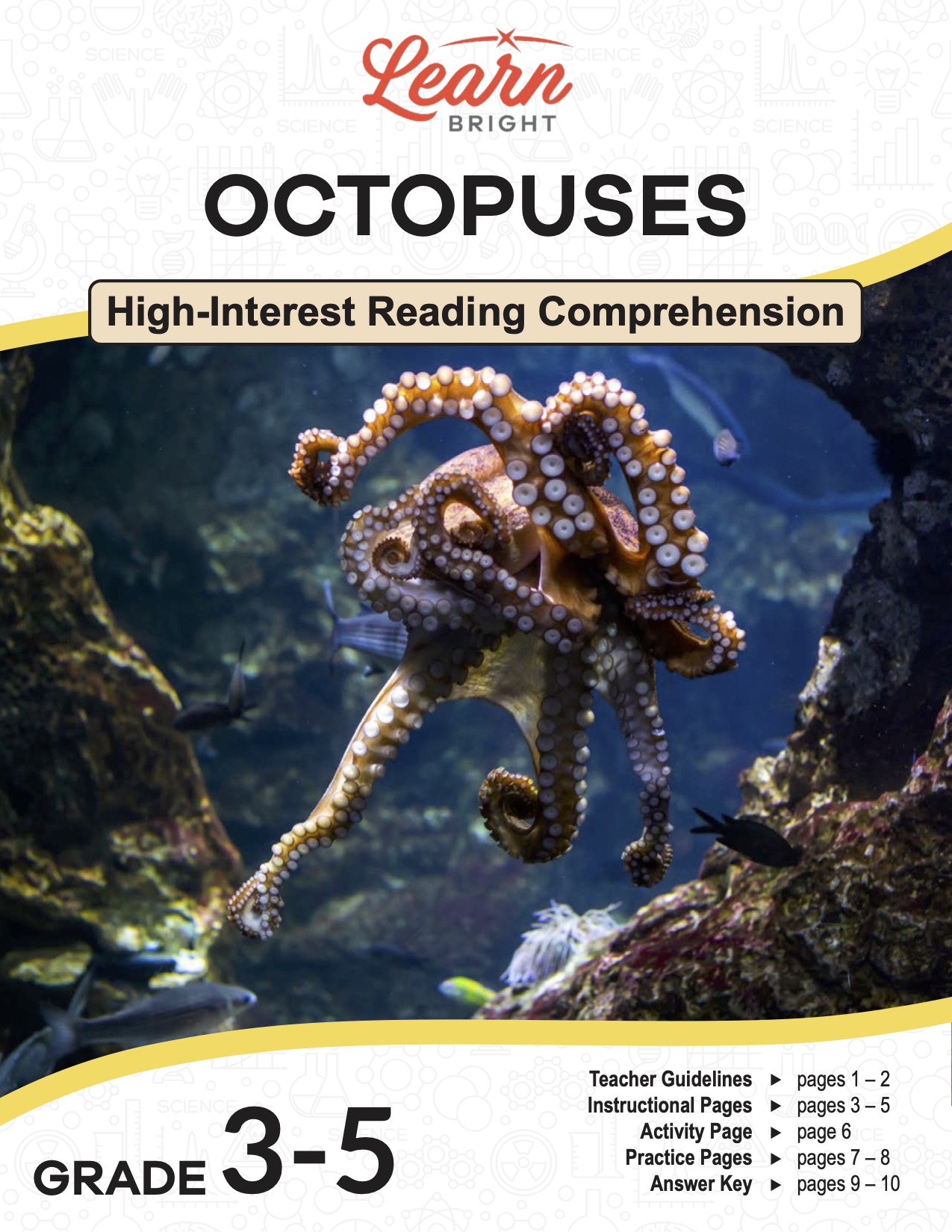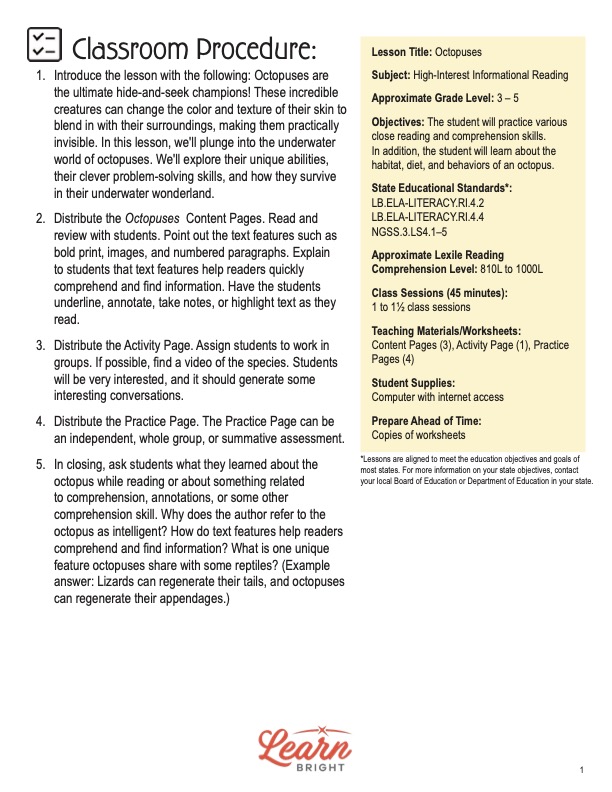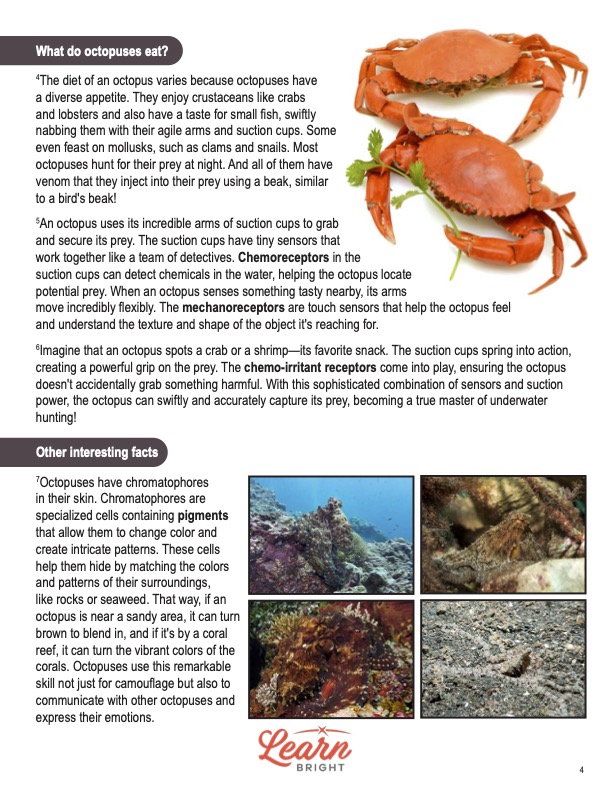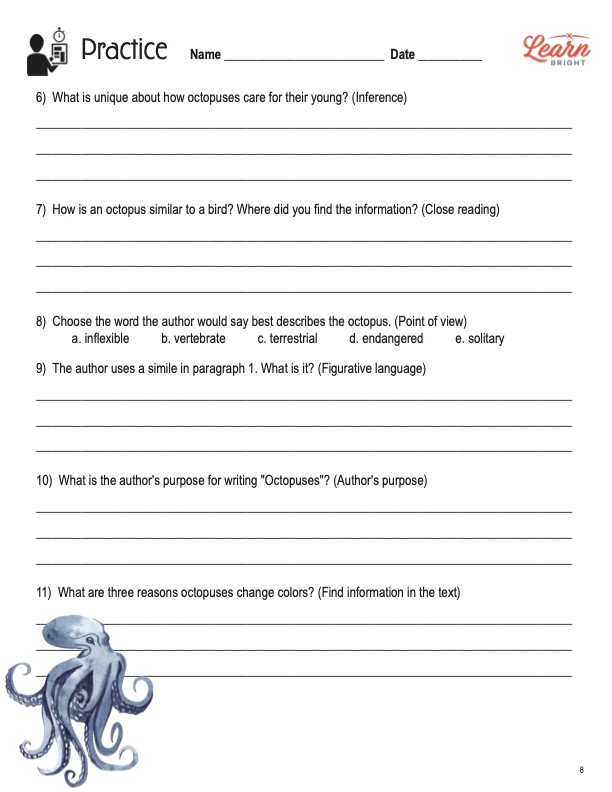Description
What our Octopuses lesson plan includes
Lesson Objectives and Overview: Octopuses is a high-interest reading comprehension lesson plan. As such, students will practice various close reading and comprehension skills. In addition, they will learn about the octopus’s habitat, diet, and behaviors. This lesson is for students in 3rd grade, 4th grade, and 5th grade.
Classroom Procedure
Every lesson plan provides you with a classroom procedure page that outlines a step-by-step guide to follow. You do not have to follow the guide exactly. The guide helps you organize the lesson and details when to hand out worksheets. It also lists information in the yellow box that you might find useful. You will find the lesson objectives, state standards, and number of class sessions the lesson should take to complete in this area. In addition, it describes the supplies you will need as well as what and how you need to prepare beforehand.
Teacher Notes
The paragraph on this page gives you a little more information on the lesson overall and describes what you may want to focus your teaching on. It explains that you can teach this lesson in a whole-class setting or as an independent, small-group activity. The blank lines are available for you to write out any thoughts or ideas you have as you prepare.
OCTOPUSES LESSON PLAN CONTENT PAGES
What Is an Octopus?
The Octopuses lesson plan contains three content pages. It begins by providing a box of background information about this animal. Octopuses are cephalopods that live in the oceans. They are carnivores, so they eat meat and not plants. They generally live between one and five years.
Octopuses are super cool sea creatures that belong to a group called cephalopods. They have soft bodies with no bones, making them really flexible. Because they don’t have a stiff skeleton, they can squeeze through tight spaces, becoming all bendy and stretchy like underwater acrobats. They have a bunch of nerve cells in clusters called ganglia that help them figure out all sorts of things. And imagine having not one but eight arms! Each arm has suction cups that can sense chemicals, touch, and irritation.
Octopuses live in the ocean and prefer to dwell in areas with rocks and hiding spots. You can find them in both shallow and deep waters around the world. Some species like to make their homes in dens or caves while others live in open areas. Octopuses are solitary animals, which means they usually prefer to live alone. However, they sometimes form aggregations when there’s plenty of food or during the mating season.
When it comes to caring for their young, octopuses have a unique way of parenting. After laying their eggs, the mother octopus guards them, gently blows water over them, and ensures they receive enough oxygen. The mother stays with her eggs and doesn’t eat during this time, showing incredible dedication to her offspring. Once the eggs hatch, the babies are left to fend for themselves, starting their journey on their own in the vast ocean.
What Octopuses Eat
The diet of an octopus varies because octopuses have a diverse appetite. They enjoy crustaceans like crabs and lobsters and also have a taste for small fish, swiftly nabbing them with their agile arms and suction cups. Some even feast on mollusks, such as clams and snails. Most octopuses hunt for their prey at night. And all of them have venom that they inject into their prey using a beak, similar to a bird’s beak!
An octopus uses its incredible arms of suction cups to grab and secure its prey. The suction cups have tiny sensors that work together like a team of detectives. Chemoreceptors in the suction cups can detect chemicals in the water, helping the octopus locate potential prey. When an octopus senses something tasty nearby, its arms move incredibly flexibly. The mechanoreceptors are touch sensors that help the octopus feel and understand the texture and shape of the object it’s reaching for.
Imagine that an octopus spots a crab or a shrimp—its favorite snack. The suction cups spring into action, creating a powerful grip on the prey. The chemo-irritant receptors come into play, ensuring the octopus doesn’t accidentally grab something harmful. With this sophisticated combination of sensors and suction power, the octopus can swiftly and accurately capture its prey, becoming a true master of underwater hunting!
Interesting Octopus Facts
Octopuses have chromatophores in their skin. Chromatophores are specialized cells containing pigments that allow them to change color and create intricate patterns. These cells help them hide by matching the colors and patterns of their surroundings, like rocks or seaweed. That way, if an octopus is near a sandy area, it can turn brown to blend in, and if it’s by a coral reef, it can turn the vibrant colors of the corals. Octopuses use this remarkable skill not just for camouflage but also to communicate with other octopuses and express their emotions.
These cephalopods have the largest brains among all invertebrates and are really smart. This is because their brains are not just in their heads but in their arms, too! Each arm has a bunch of neurons, or tiny brain cells, that work together to help an octopus move its arms in a coordinated way. The unique way their brains are spread out in their arms helps octopuses solve problems and adapt to different situations. It’s like having a team of helpers in each arm, making them really good at figuring things out and dealing with the changes around them.
When octopuses need to protect themselves, they use an incredible strategy called autotomy. If an octopus is in danger, it will purposely “let go” of one of its arms. It can then escape its predators because its detached arm keeps moving as a distraction while the octopus makes a safe getaway. Even more amazing is that octopuses can grow a new arm later.
Why Are Octopuses Important?
These wonderful and unique creatures play a vital role in their environment because they help control the population of other sea creatures. They also serve as a food source for larger predators, contributing to the intricate web of life in the ocean. Most octopus species are not considered endangered. However, pollution and overfishing can impact their homes in the sea.
Humans also enjoy eating octopuses, so ensuring we catch them sustainably and care for their habitats is necessary. By understanding and respecting these incredible marine animals and their environment, we can help ensure that they continue to thrive and contribute to the health of our oceans.
OCTOPUSES LESSON PLAN WORKSHEETS
The Octopuses lesson plan includes two worksheets: an activity worksheet and a practice worksheet. Each one will help students solidify their grasp of the material they learned throughout the lesson. You can refer to the classroom procedure guidelines to know when to hand out each worksheet.
PACIFIC NORTHWEST TREE OCTOPUS ACTIVITY WORKSHEET
For this lesson, students will need to put their thinking caps on. In their groups, they will research the Pacific Northwest tree octopus and learn why it differs from other species. They will answer the questions on the page and explain whether they think this octopus is a myth or a hoax.
OCTOPUSES PRACTICE WORKSHEET
The practice worksheet requires students to answer a series of 11 questions. These questions all relate to the content pages, so students will need to refer to them often for the answers. In addition, each question provides which reading tool the question corresponds to, such as text feature, vocabulary, or comprehension.
Worksheet Answer Keys
At the end of the lesson plan document is an answer key for the practice worksheet. The correct answers are all in red to make it easier for you to compare them with students’ responses. If you choose to administer the lesson pages to your students via PDF, you will need to save a new file that omits these pages. Otherwise, you can simply print out the applicable pages and keep these as reference for yourself when grading assignments.










